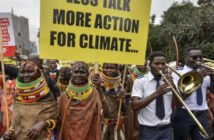Tens of thousands of delegates and world leaders from nearly 200 nations will be descending on Paris today where, for the next 12 days to two weeks, they’ll be hammering out an international climate agreement – one expert believe could be a major turning point in the fight to stop global warming.
The accord – expected but far from assured – will not be enough to stop temperatures from rising by more than 2 degrees Celsius from pre-industrial levels, which scientists say is the rough benchmark for avoiding global warming’s worst effects.
But after the misfires and mixed messages of the past two decades, last-minute withdrawals and heartbreaking collapses of prior summits, the anticipated agreement – if achieved – would enshrine serious commitments by nearly all nations to reduce their heat-trapping carbon emissions – finally, perhaps for the first time, capturing the political will for nations to work together to stop climate change.
“It’s putting in place this framework that builds trust over time,” says Nathaniel Keohane, vice president for global climate at the Environmental Defense Fund. “A framework to keep increasing their ambition going forward.”
There’s much that still has to happen between here and there. For those following from afar, read on to learn what to expect from the negotiations – and the long nights – ahead: Negotiators have spent more than two years laying the groundwork for this meeting. In the past nine months alone, starting with Switzerland, 149 nations have submitted what’s known as their Intended Nationally Determined Contributions, or INDCs – public pledges for how they plan to reduce their greenhouse gas emissions starting in 2020.
This approach was formulated after what many regard as the failures of two previous agreements
- The Kyoto Protocol of 1997, which the U.S. Senate declined to ratify and ultimately killed by George W. Bush administration, which argued it would harm the country’s economy while giving developing nations like China a pass.
- The Copenhagen Summit in 2009, which was seen as too lenient, which contributed to talks there descending into disarray, yielding only a weak statement on climate.
“What we’re aiming for in Paris is what we refer to as a hybrid approach: something that combines top-down and bottom-up elements,” Diringer explained at a recent meeting with reporters. “National flexibility, on the other hand international discipline, with the goal of achieving both broad participation and strong accountability and ambition.”
For the few first days of the conference, small teams of negotiators will weed through designated sections of the draft agreement, trying to eliminate bracketed areas that signal disagreement and to cut the length from 40 pages. The following Saturday, the revision will then pass to the French presidency, which will work with international energy and environment ministers, secretaries and undersecretaries to reach a final agreement.
“We’re probably closer than the heavily bracketed text might suggest, but there is still a ton of work to be done,” Diringer says.



